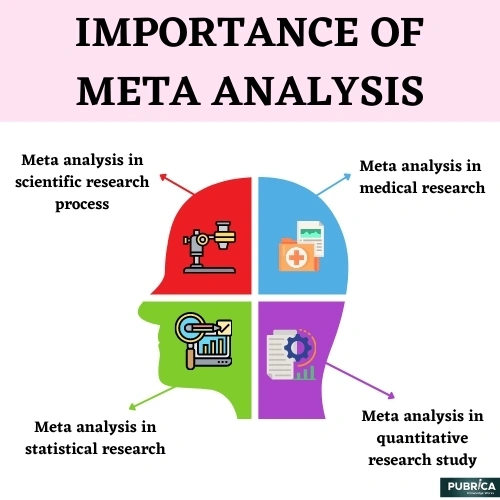
What are the Consequences of Plagiarism in Scientific Writing?
January 6, 2021
Strategies to upgrade Clinical Trial Quality in this Computerized World?
January 18, 2021Importance of Meta-analysis in Medical Research
In Brief
- Meta-analysis Writing Services provides a statistical approach that incorporates the findings of multiple studies on the same subject and can overcome conflicts between studies. There is a growing use of meta-analysis, and it plays an important role in medical science.
- The basic principles, measures, benefits, and caveats of writing a meta-analysis are presented in this study to help clinicians to understand it in clinical practice and research.
- Meta-analysis paper writing offers major benefit of a meta-analysis is that it provides a reliable estimation of the effect size, with substantially improved statistical capacity, which is important when a limited sample size limits the power of the primary study.
Introduction
New medical studies are always published, and clinicians face exponentially vast volumes of new data, to the point that it has become almost impossible for clinicians to read and interpret all available medical data. Furthermore, the research findings are not reliably reproducible, and the outcomes of individual studies are frequently inadequate to provide confident answers. Many studies have false-positive (type I errors) findings or cannot detect minor effects (type II errors, false-negative). Consequently, where the reported results are contradictory, or the sample size is too small to be reliable, clinical decision-making is complicated. The best suggestion available in the medical literature is evidence-based medicine. The best proof of evidence-based medicine comes from meta-analyses that include a less biased, more reliable clinical problem assessment. “Meta” comes from “after” or “beyond” in Greek; a meta-analysis is an “analysis of analyses”. In other words, it is a statistical procedure for integrating the findings of various studies on the same subject and, in clinical science; it is becoming famous for resolving discrepancies. As such, a meta-analysis is an empirical, quantitative synthesis of research findings that incorporates the results of previous studies to improve the statistical strength and precision for estimating effects and thus, overcoming the problem of small sample sizes and inadequate statistical power. Our meta-analysis experts’ provide a detailed origins of heterogeneity that can be examined through meta-analysis and subgroups associated with the factor of interest, potentially providing new insights for future studies.
Meta-analysis in medical research
Writing a meta-analysis paper itself is a design of a quantitative, formal, epidemiological study used to systematically analyze previous studies’ findings to conclude that research body. Usually, but not always, randomized, controlled clinical trials are the basis of the study.
How to perform a Meta-analysis
For the statistical analysis of a meta-analysis, general or specialized statistical programs, such as STATA, S.A.S., R, Examination Manager, or Systematic Meta-Analysis, are used. The general method of medical studies meta-analysis
- Identify relevant research: PubMed, EMBASE, CENTRAL
- Check between-study heterogeneity: Cochran Q test, I2
- Meta-analysis: fixed/random effect model, Forrest plot
- Evaluate sources of the heterogeneity: subgroup analysis, sensitivity test, meta-regression
- Check publication bias: funnel plot, Egger’s regression test, trim and fill method
- Present meta-analysis result based on PRISMA
How to write meta-analysis paper
Systematic reviews of writing intervention studies are a useful approach for recognizing instructional strategies that can change students’ writing. Meta-analysis is the systematic approach we have used in this study. Meta-analysis research approach summarizes the extent and course of the impacts of several empirical studies. A review identifying effective writing practices at the elementary level will need for three reasons. First, teacher practices have raised important questions about the quality of writing instruction received by elementary grade students. It is, therefore, necessary to recognize writing therapies with proof of efficacy. Second, there is a growing agreement that is waiting to fix literacy issues until later grades. It is not sufficient to have their roots in earlier phases. Thirdly, only with elementary grade students, there is no systematic meta-analysis of writing treatments performed.
Meta-analysis in quantitative & statistical research
Meta-analysis in Medical research methodology includes examining the theory, processes, and results of qualitative research and synthesizing these observations into new ways of thinking about phenomena. Meta-analysis research help reflects the research strategy in Quantitative research, especially in health sciences, which results from various studies using similar techniques, data sets and analytical methods. Meta-synthesis often takes place within a precise academic and theoretical framework, and that context ultimately influences the content and type of interpretations. Therefore, we have realized that all constructors of phenomena are fundamentally historical and that even our best understandings will still be subject to changes that may arise over time and in various contexts.

The Research processes in meta-study
The meta-analysis includes study accompanied by synthesis. Four components are used in the research procedures of the meta-study: meta-data-analysis, meta-method, meta- theory and meta-synthesis.
1) Meta-Data-Analysis
- Identifying an analytic strategy
- Developing filing and coding system
- Categorizing the data
- Discussing and interpreting findings as they relate to a research question
Meta-data-analysis is the study using retrieving “processed data” of published research results in a specific substantive field of investigation. This approach is aggregative and informative, requiring researchers to analyze several accounts of a phenomenon to uncover the similarities and differences between accounts.
2) Meta-Method
- Specifying methodological characteristics of selected reports
- Elaborating on how methodological factors influenced research findings
The analysis of the rigour and epistemological soundness of the research methods used in research studies is a meta-method. Since methodological choices play a significant role in directing future research in a particular field of study, meta-method contributes to the theory’s advancement and provides a conscious forward movement strategy.
3) Meta-Theory
- Identifying primary cognitive Para diagrams/schools of thought that will represent in the theoretical frameworks and emerging theory of reports
- Relating theory to larger social, historical, cultural, and political context
- Uncovering significant assumptions under-lying specific theories
4) Meta-Synthesis
Meta-synthesis will derive from the results of the analytic components.
- Critically interpreting the strengths and limitations of the various discrete contributions to the field
- Uncovering significant assumptions under-lying specific theories
- Searching for alternative explanations for paradoxes and contradictions within the field
Hence, meta-analysis as a methodological strategy to help us link subjective with objective realities, speculative truths with probable truths, and theoretically intriguing possibilities with practical, real-world applications.
Conclusion
In medical science, statistical meta-analysis covers a broad range of subjects, from risk factors to prognosis. Therefore, for a wide range of subjects, including biomarkers, genetic factors, diagnosis, and treatment, meta-analysis is appropriate. It is also a useful tool for integrating the findings of multiple studies and critically summarizing existing literature on a particular topic. Meta-analysis is the invaluable bridge between past and future research studies. Therefore, understanding meta-analysis is valuable for clinicians in the process while making clinical decisions.
References
- Guyatt GH, Sackett DL, Sinclair JC, Hayward R, Cook DJ, Cook RJ. User’s guide to the medical literature. IX. A method for grading health care recommendations. Evidence-Based Medicine Working Group. JAMA. 1995;274:1800–1804.
- Murad MH, Montori V.M., Ioannidis J.P., et al. How to read a systematic review and meta-analysis and apply the results to patient care: users’ guides to the medical literature. JAMA. 2014;312:171–179
- Button KS, Ioannidis JP, Mokrysz C, et al. Power failure: why small sample size undermines neuroscience reliability. Nat Rev Neurosci. 2013;14:365–376.





